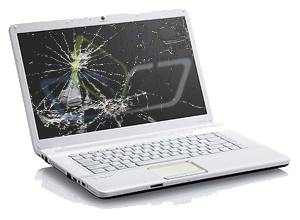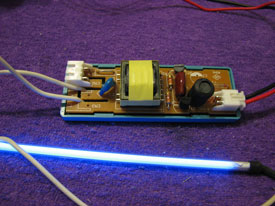Laptop Screen Replacement

Laptop LCD Screen Repairs
Unfortunately, many people at one time or another find themselves in a situation where they have dropped their laptop or in some other way have damaged their laptop LCD screen. In fact, this is a rather common occurrence in this age of advanced mobile technology. Especially with more and more schools and universities encouraging students’ use of laptops, the need for laptop LCD screen repairs is more common than ever.
It is highly recommended that you do not attempt to repair your laptop LCD screen on your own. In order to prevent any further damage to your machine, it is best to have the repairs done by an experienced computer specialist.
In some cases it is not the screen that is at fault!
This is why it is important to have the damaged laptop properly assessed. Without the correct skills, tools, and relevant compatible spare parts to carry out a proper diagnosis, you could be attempting to fix a laptop that is beyond economical repair or cause further unnecessary and costly damage.
(1) It can be a loose or damaged video cable or connector.
(2) A faulty “Graphics Chip” which can be on the motherboard – would require a new laptop motherboard.
(3) A faulty separate “Video Card”, which is plugged into the motherboard – would require a new video card.
(4) A faulty “Power Inverter Circuit Board”, only on older CCFL backlight laptop screens.
(5) Or possibly several of the above faults.
In order to determine the extent of the damage and provide the customer with a proper quote, the laptop will need to be dismantled physically. In many cases, the company responsible for the manufacturing of the LCD screen is not the same as that of the computer. The primary reason for this is that it is not uncommon for two identical machines to have very different LCD screens. Laptop LCD screens must be repaired or replaced on a case by case basis to ensure the correct connectors, inverter and motherboard voltage and have the correct dimensions to fit in the laptop casing.
PRICES:
Screen Fitting costs £30. Most replacement screens cost between £50 and £70.
(1) Most of the LED backlight screens are in the £50 – £60 price bracket. (Some very thin LED screens (commonly called “razor”) can cost as much as £90.)
(2) Most of the CCFL backlight screens are in the £60 – £70 price bracket.
This exact price depends on :-
(1) How quickly you want the screen repaired, 2-3 days or possibly 1 week.
(2) What type of warranty you want on your new screen, several months, 6 months or 1 year.
(3) Whether you want a “Matt” or “Glossy” replacement.
(4) Whether you want an identical screen or a compatible screen.
(5) Manufacturer of the screen, sometimes their might be a possible choice of an even better quality screen at a different price.
(some laptops over 2 years of age may only be suitable for compatible screens, ie. that exact screen is no longer manufactured.)
I prefer the quality of LG-Phillips and Samsung glossy screens. Although, a lot of new screens are very similar in quality and are often made and assembled in China.
How long would it take to replace the new screen?
It can be done within 3 days, as unlike other local computer competitors I do the fitting myself. If you are willing to wait up to a week I can sometimes make a cheaper quote because the postage and delivery is then cheaper, or I can sometimes purchase several screens at the same time and then also reduce the delivery cost.
Can an exact or a compatible replacement be reliably identified by the Laptop make and model?
No, even the same Laptop from a different batch of production can have a different make of screen, and sometimes it has different connectors as well. The only reliable way to identify the screen 100%, is to unscrew the screen bezel and remove the broken panel. On the back of the panel there is a unique manufacturer identity number, the type and location of the connectors is also noted for reliable replacement of a compatible screen.
What type of warranty dose the new screen have?
I often try and get a 1 year warranty. Some suppliers only give a warranty of a couple of months. Bear this in mind when you are comparing my quotes with other local competitors.
Can an older Laptop have a newer LED screen fitted instead of the current CCFL screen?
No, the technologies are completely different. LED screens do not have a “Power Inverter Circuit Board”. (Once the screen bezel is removed, you’ll see the LCD in its metal frame, on most notebooks the inverter board is directly below the screen).
Are there any risks involved in replacing a laptop screen?
Yes :-
(1) The small rubber screw covers that are on the front of the display’s bezel (surrounding frame) have to be carefully removed. After the screen is replaced these covers often have to be re-glued. You have to use the correct type of glue else you will easily mark the plastic screen bezel. I have seen laptops repaired by the original manufacturer that have used the wrong type of glue or “too much” glue that has marked the screen bezel. This damage is very visible when you are looking at the front of the screen.
(2) On older laptops, the plastic clips which secure the screen bezel to the rear plastic of the screen cover can become brittle with age and snap off. Sometimes the “Screen Bezel” has to be replaced if too many clips break off.
(3) You have to be very careful with all the intricate parts hanging out of the open screen. You really need three hands. The connectors are very delicate and are easily bent or broken. Unless you do this sort of work every day, you probably would not have the required dexterity to replace the screen without scratching it or its exposed plastic bezel.
If the screen is completely black, is the screen really broken?
No, on older laptops with CCFL backlight panels, in 90% of cases the screen is not broken. The “Inverter Circuit Board” is faulty instead. This can usually be replaced, and is cheaper than a new screen. Often £20 – £30 plus fitting charge of £25.
Are you properly qualified in Electronics and Computer Repair?
Yes, all work is carried out by Terry Spiers, a qualified Computer Professional (Microsoft Certified Professional for 11 years with a HND in Electronic Engineering). Having previously worked for more than 10 years as a Senior Computer Technician and Computer Officer at the Universities of Birmingham, Warwick and Worcester. Professional service with over 20 years experience in the IT industry.
LED versus CCFL Screens:
The big “green” saving grace of LED’s versus CCFL’s, is the lack of mercury content in LED’s, the current claims are that LED screens use less energy and will outlive CCFL Screens. Recently, NEC proclaimed that LED technology would double the longevity of a monitor backlight from 25,000 hours to 50,000 hours.
It is generally considered that these new LED screens offer brighter colours and better contrast, but is this true?
In my humble opinion this is true for LED-IPS panels, but most of the cheap LED panels that are currently being imported from China are inferior LED-TN panels. Their colours are not accurate and they are already failing on mass. These new LED screens can not tolerate even the simplest of shocks. Their liquids easily disperse into a complete mess.
I have already replaced many faulty LED screens for Aberystwyth University students. Some of these laptops were only a couple of months old.
Current LED-IPS panels have very accurate colours and they have zero black or white crush (ie. every shade of extreme blacks and whites can be discerned on test images). They are only found in high end LCD monitors that are expensive.
LCD Backlights:
Physics Lesson – What is CCFL ?
Answer: It is a LCD Backlight.
 Cold Cathode Fluorescent Lamp technology is in effect a miniature fluorescent tube powered by a tiny electronic circuit called a “Power Inverter” or just “Inverter” for short. (It is called an “inverter” because of the “inversion” of a switching transformer operated in saturation.)
Cold Cathode Fluorescent Lamp technology is in effect a miniature fluorescent tube powered by a tiny electronic circuit called a “Power Inverter” or just “Inverter” for short. (It is called an “inverter” because of the “inversion” of a switching transformer operated in saturation.)
A fluorescent lamp requires a high voltage AC (alternating current) supply. A laptop battery only supplies a low voltage DC (direct current) supply.
An inverter circuit is comprised mainly of a step-up transformer and a ballast capacitor. The leakage inductance of the transformer and a capacitance component obtained on the secondary side of the transformer form a LC resonant circuit.
By using a switched DC supply on the primary of a step-up transformer, a high voltage AC current is produced in the secondary of the transformer, ie. by using an electromagnetic step-up transformer a small battery can produce a high voltage alternating signal to power a fluorescent lamp. A ballast capacitor is essential for the stabilization of the lamp current.
LED backlight screens do not use a florescent lamp and inverter circuit to power it. These LED Screens have a pattern of LED’s (light emitting diodes) behind the liquid crystal display. Powered directly by the laptop battery.
NB. I have obtained City and Guilds, OND and HND qualifications in Electrical/Electronic Engineering.
